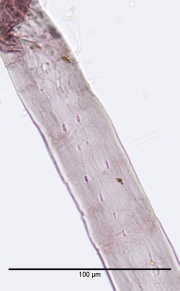Western hemlock
Description
A strong, tall hemlock, Tsuga heterophylla, native to the northwestern Pacific coast of Canada and the U.S. The western hemlock produces a soft, lightweight wood with a straight, fine grain. Peak production was in 1927. The lumber was used for millwork, construction, boxes, fences, and boats.
Synonyms and Related Terms
Tsuga heterophylla; Pacific hemlock; west coast hemlock; werstern hemlock-spruce; hemlock fir; Prince Albert's hemlock
Physical and Chemical Properties
- Height = 50-70 m, diameter up to 3m; branches are drooping
- Bark = thin, brown with furrows
- Leaves = needles are 5-23 mm long and 1.5-2 mm wide
- Density = 28 pcf
- Cones = small, cylindrical (14-20 mm long)
- Density = 28 pcf
Paper fiber type: softwood. Using transmitted light microscopy, fibers are identified by the presence of small piceoid and cupressiod ray parenchyma pits. Ray tracheids are non-dentate and usually collapsed. Appearance with Graff "C" stain: varies with pulping method. Average dimensions of fibers: length, 4.2mm; width, 30-40 μm. Common pulping method: kraft (sulfate) and sulfite.
Resources and Citations
- G.S.Brady, Materials Handbook, McGraw-Hill Book Co., New York, 1971 Comment: p. 394
- Dictionary of Building Preservation, Ward Bucher, ed., John Wiley & Sons, Inc., New York City, 1996
- External source or communication Comment: West Coast Lumbermen's Association, Seattle, Wash.: air-dry weight = 28 pcf
- Encyclopedia Britannica, http://www.britannica.com Comment: "hemlock." Accessed: 19 Oct. 2004 .
- Marja-Sisko Ilvessalo-Pfäffli. Fiber Atlas: Identification of Papermaking Fibers (Springer Series in Wood Science). Springer, 1995.
- Walter Rantanen. 'Fiber ID Course.' Integrated Paper Services. June 2013. Lecture.

